From darkness to everlasting light: all you need to know about the first Islamic Arts Biennale
Rebecca Anne Proctor travels to Jeddah to explore the world’s first Islamic Arts Biennale (until 23 April), a monumental survey of Islamic arts and culture in the religion’s birthplace, modern-day Saudi Arabia
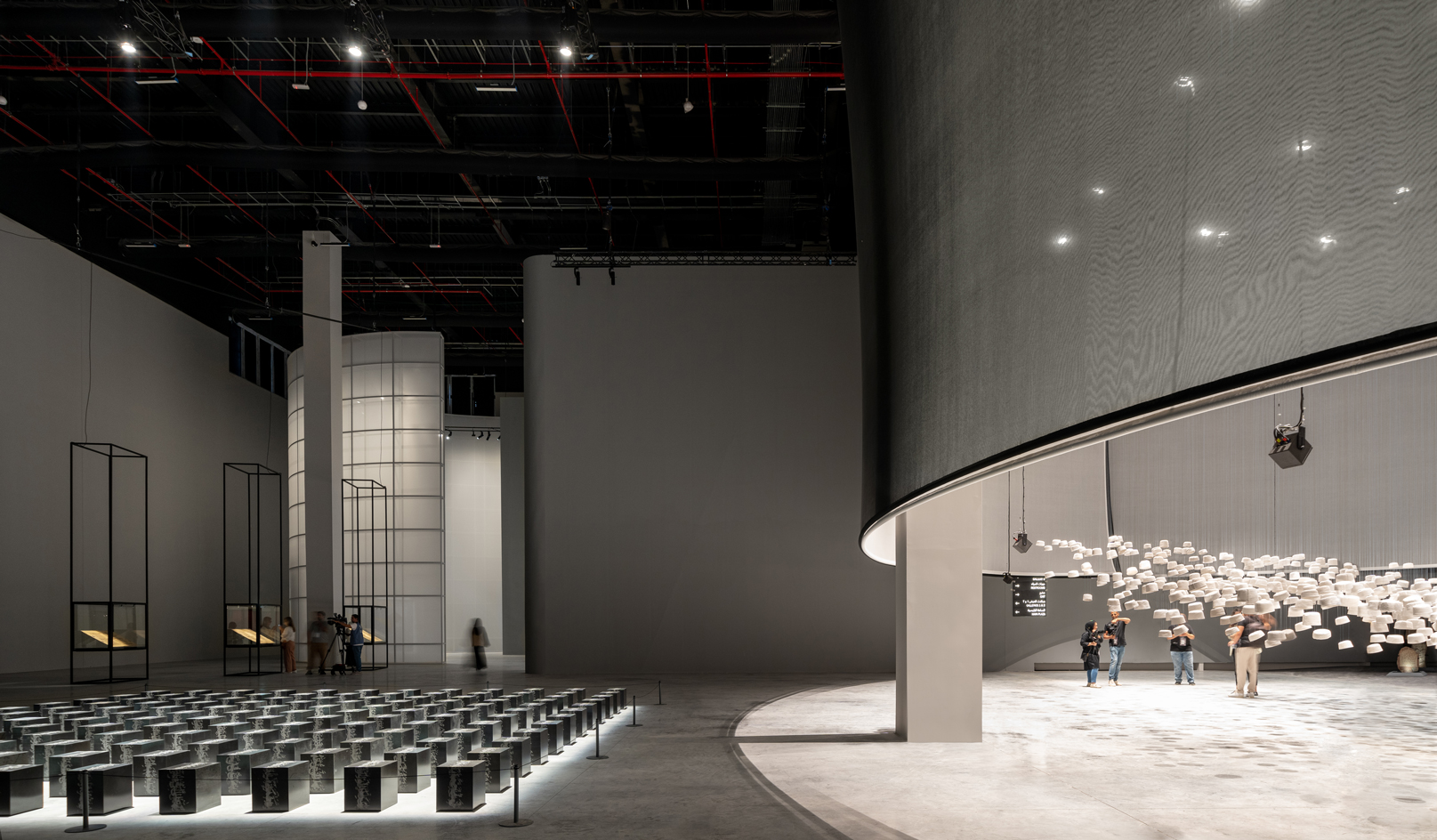
A surprising shroud of darkness greets visitors to the first Islamic Arts Biennale in Jeddah, Saudi Arabia. In the first gallery, amidst the blackness are the chant-like sounds of American-Lebanese media artist Joseph Namy’s Cosmic Breath, in which recorded prayers from various countries are played powerfully in unison. Across the room are Saudi artist Nora Alissa’s haunting black-and-white photographs, arranged in a triptych. Titled Epiphamania: The First Light, the evocative pictures depict pilgrims around the sacred Kaaba, the building at the centre of Islam’s most important mosque, Masjid al-Haram in Mecca, Saudi Arabia, which Alissa photographed from underneath her abaya. Just a few steps away is a series of historic astrolabes dating to the 17th century. They serve as a reminder of the contributions Islamic philosophers have made to discoveries in astronomy, geometry, and mathematics for centuries.
Under the theme of ‘Awwal Bait’, which means ‘first house’ in Arabic, these works – traditional and contemporary displayed in together in the birthplace of Islam – act as a precursor for the rest of the exhibition which, as the visitor moves from darkness to light, balances its 280 works of Islamic historical objects and artefacts with 60 newly commissioned contemporary artworks. The effect is at once ritualistic, meditative, and mystical.
Staged at the Western Hajj Terminal at the city’s King Abdulaziz International Airport, used during the hajj for once-in-a-lifetime pilgrimages to Mecca, the world’s first Islamic arts biennale offers a cultural and metaphysical exploration of the artistic heritage of Islam.
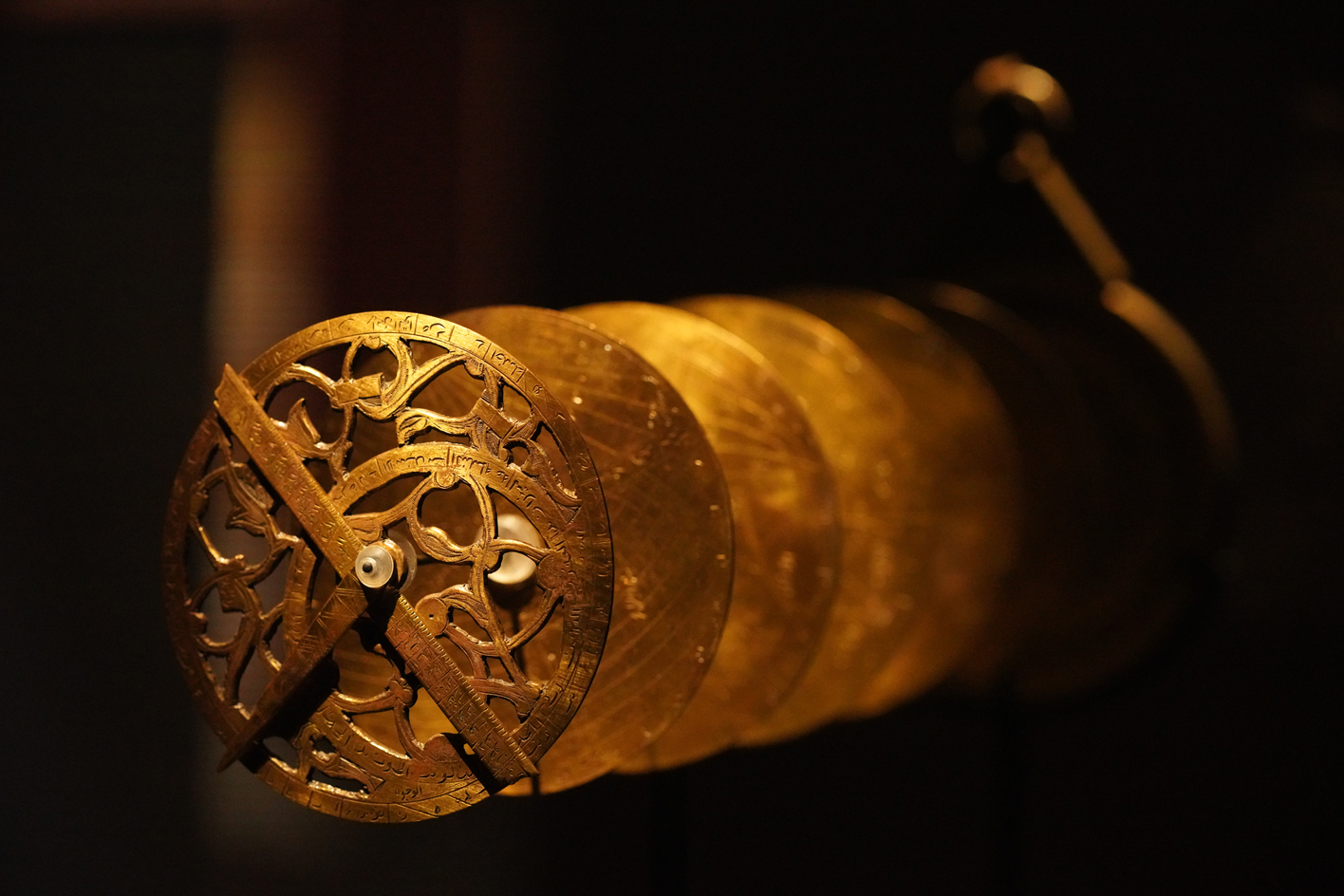
A series of historic astrolabes dating to the 17th century, on view as part of the Islamic Arts Biennale
The first Islamic Arts Biennale: history in the making
‘This is a historic moment not just for Saudi Arabia but for the entire Muslim world,’ said Sumayya Vally, artistic director of the biennale, the South African architect and principal of Johannesburg-based architectural studio Counterspace. ‘At its essence, this biennale is about giving contemporary objects a home by giving them a lineage, and giving historic objects a home by giving them a future.’
Working alongside the exhibition’s curators – Saad Alrashid, a leading Saudi scholar and archaeologist; Julian Raby, director emeritus of the National Museum of Asian Art at the Smithsonian Institute in Washington DC; and Omniya Abdel Barr, an Egyptian architect and Barakat Trust Fellow at the V&A – Vally drew much of her inspiration from her own experiences in the Western Hajj Terminal, as a pilgrim looking up into the canopies, surrounded by pilgrims from around the world. The artworks in the exhibition are physically oriented towards the Qiblah (the direction of the sacred Kaaba, the building at the centre of Masjid al-Haram in Mecca), as if they too were in a call to prayer. They are divided into six galleries with themes reflective of Islamic ritual: Adhan: The Call; Wudu’: Purification; Salah: Prayer; Salat Al-Jama’ ah: Congregational Prayer; Mawt: Mortality; and Bait: House of God.

Installation view of the first Islamic Arts Biennale in Jeddah, featuring scenography designed by architecture studio OMA
The biennale has been staged by the Diriyah Biennale Foundation, established in 2020 by the Saudi Ministry of Culture to produce the country’s first-ever art biennales. These biennales – of which the Islamic Art Biennale is the second – are some of the numerous new cultural activities being rolled out at rapid speed as part of the kingdom’s Vision 2030, crown prince and prime minister Mohammed bin Salman’s strategic plan. Its stated goal is to diversify the economy, reduce its dependence on oil, and transform Saudi society.
Wallpaper* Newsletter
Receive our daily digest of inspiration, escapism and design stories from around the world direct to your inbox.
As this inaugural biennale demonstrates, at the core of such a vision is an emphasis on preserving and upholding Saudi identity, Islam and wider Islamic culture.
A harmonious marriage between conceptual or abstract works and traditional Islamic art creates an enlightening and serene air in the biennale. Traditional works include the doors of the Kaaba; some of the oldest Quranic manuscripts in existence; and intricately made sitaras (curtains that cover the Kaaba).
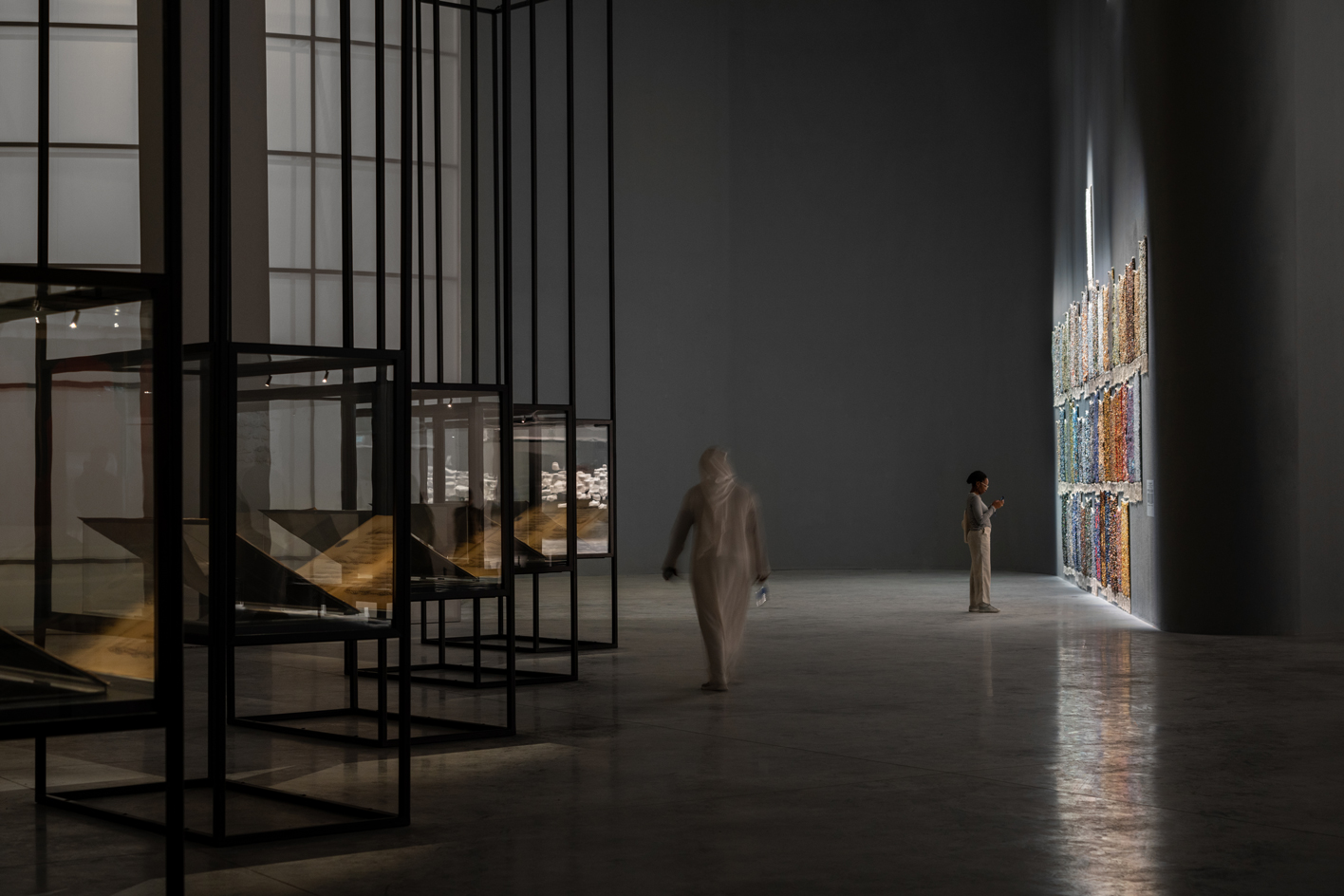
Installation view of the first Islamic Arts Biennale in Jeddah, featuring scenography designed by architecture studio OMA
Among the contemporary artworks that create a similarly mystical and enchanting experience is a work by Saudi artist Muhannad Shono, who represented Saudi Arabia at the 2022 Venice Biennale. It is titled Letters in Light, Lines We Write (2023), and takes the viewer on a journey through light, sound and suspended geometric shapes, which sevokes a personal relationship with the spiritual. Saudi artist Basmah Felemban’s Wave Catcher (2023) places large wooden circular forms in space to reflect the adhan (call to prayer), with the spheres representing sounds and their size, shape and place indicating their duration and pitch. These forms also evoke traditional drums or the fishing traps used on the east coast of Saudi Arabia.
Towards the end of the gallery section, South African artist Igshaan Adams displays used prayer mats from the Bonteheuwel district of Cape Town, his hometown. They glisten with semi-precious stones, cotton thread, dye, wire, and beads. Also from South Africa, in an adjacent expansive room, is Haroon Gunn-Salie’s Amongst Men, comprising 1,000 cast kufiyah hats. It is a reference to the funeral procession of Iman Abdullah Haron, a South African Muslim community leader killed by apartheid police in 1969. The work, while based on an act of violence, has an ethereal air: the multitude of white hats suggests a resurrection where the spiritual realm transcends the earthly.
What constitutes Islamic art?
While the synergies between past and present Islamic art weigh powerfully in this first biennale, the question that remains for many is: what constitutes Islamic art? Why stage a biennale titled ‘Islamic, and why aren’t there biennales of Christian, Jewish or Hindu art?
The reasoning Islamic scholars often give emphasises the power of Islam itself as a culture—one that is as expansive geographically and culturally as it is in faith.
‘Islamic art refers to a great range of cultures within a very large geographical area,’ explains William Lawrie, co-founder of Lawrie Shabibi, a gallery in Dubai and a former specialist at Christie’s Islamic art department ‘For those who appreciate or study Islamic art, there’s always an inherent understanding or agreement that the genre is a placeholder for a much larger idea. At least in terms of historical Islamic art, you would be referring to an art from various geographical areas ruled by Muslims, or where Islamic culture in one way or another has perfused into the local visual culture.’

Installation view of the first Islamic Arts Biennale in Jeddah, featuring scenography designed by architecture studio OMA
Islamic art has rarely been given such an international spotlight. The last time a large-scale exhibition was mounted was in 1976 for the World of Islam Festival in London, intended to quell tensions between Christians and Muslims in England. The Islamic Arts Biennale in Jeddah is not only grander and more comprehensive in scale, it also brings the genre of Islamic art back home to its birthplace, while still professing its inclusiveness and universal vision.
Importantly, as Vally stresses, this Biennale offers the Islamic world, both past and present, an opportunity to finally be seen and heard on the world stage in the birthplace of Islam. It is a biennale that includes artists from across the Islamic world, including Iran, Pakistan, and Bangladesh.
A homecoming: the past and future of Islamic art
While the experience of darkness, like that of a black shroud, might at first be a surprising commencement to a groundbreaking first biennale of Islamic art, it also metaphorically connects the artworks, the architecture, and the universality of Islam. As visitors make their way through the show, they find themselves moving towards the light, a metaphor for the journey of the soul towards resurrection or eternity.
The scenography, which has been designed by architecture studio OMA, becomes increasingly illuminated until visitors find themselves outdoors, under the terminal’s series of sand-coloured fiberglass fabric tents suspended from steel pylons. The terminal itself was designed by American studio Skidmore, Owings & Merrill in the 1980s. In 1983 the structure was the recipient of the Aga Khan Award for Architecture.
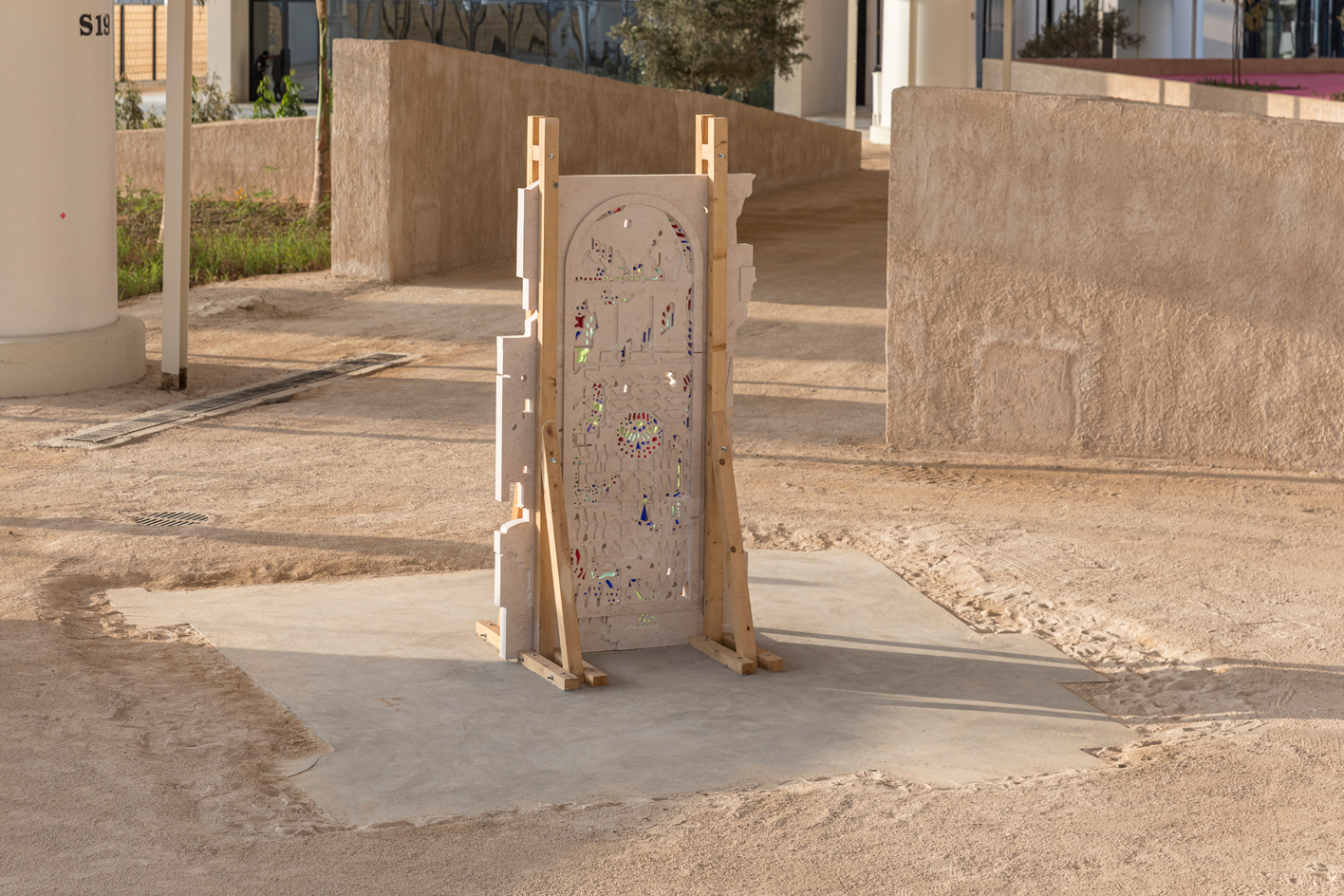
Installation view of Palestinian artist Dima Srouji’s Maintaining the Sacred, one view as part of the Islamic Arts Biennale in Jeddah
‘Our work aims to create an umbrella that houses Islamic art and complements the existing Western Hajj Terminal Structure,’ OMA associate Kaveh Dabiri said. ‘We catered the design around the idea of moving from darkness to light with always a focus on the art pieces displayed. The fourth gallery is meant to be an explosion of light. The spaces we created are meant to offer an intimate, calming, and meditative experience, with only objects or works of art in the spotlight.’
The outdoor space, titled ‘Under the Canopy: Hijrah (Migration)’ is the area encompassing the most light. It refers to the journey of Prophet Muhammad and his followers from Mecca to Medina. Outside, amidst the various large-scale artworks, are two pavilions dedicated to Mecca (the holiest city in Islam) and Medina (meaning ‘the enlightened city’ and second holiest city after Mecca), housing newly commissioned works such as Kuwaiti artist Farah Behbehani’s The Path of Light, a large circular hand-embroidered kinetic installation that reflects on Prophet Muhammad’s time in the city of Medina following the Hijrah (the migration of his followers after persecution in Mecca).
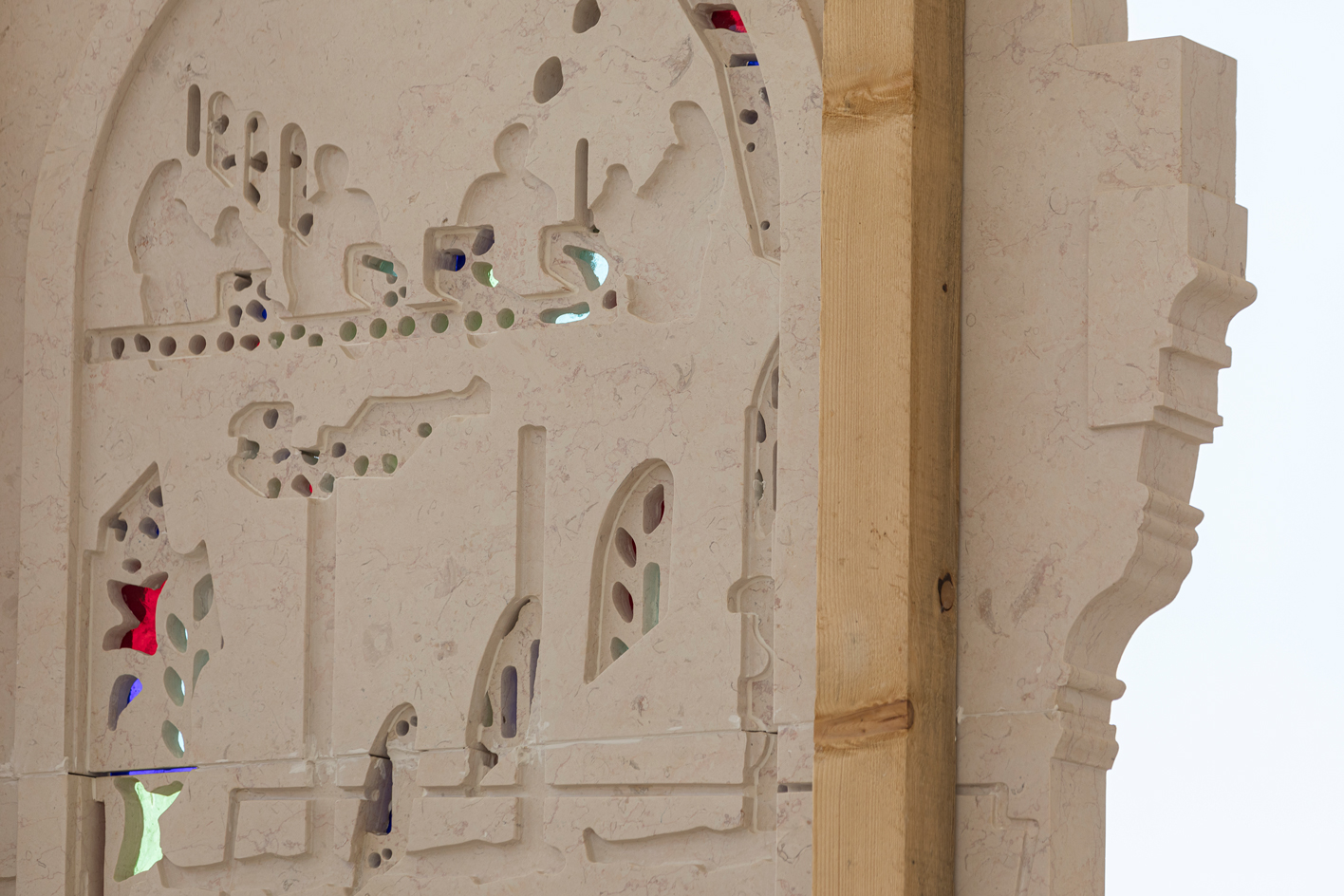
Detail of Dima Srouji’s Maintaining the Sacred
Among the notable works outside is Palestinian artist Dima Srouji’s Maintaining the Sacred, a large erect slab of jaggedly cut stone in plaster with coloured pieces of stained glass. The piece stems from the incursion into the Haram Al Sharif in Jerusalem by Israeli forces on 15 April 2022, which destroyed 30 coloured glass windows known as qamariyyas in the Dome of the Rock and Al-Aqsa Mosque. According to Srouji, it will take 15 years to repair all windows, and Israeli forces are presently blocking the reconstruction.
‘This work is [an] ode to the glass craftsmen in Palestine who have been trying to repair the windows,’ she says.
It is South African artist James Webb’s installation on the opposite side of the exterior space titled A Series of Personal Questions Addressed to a Boat that Sailed Its Last Journey on the Red Sea (2023) that sums up the universality of the theme of ‘Awwal Bait’, and the quest to define what ‘home’ means for everyone, not just Muslims. It is heart-wrenching. The salvaged traditional wooden boat once used on the waters of Arabia in the Red Sea is coupled with the sound of an enchanting voice in Arabic and English that prompts the onlooker and the listener to consider the spiritual, social, ecological, and personal aspects of home. In this area of the Western Hajj Terminal, visitors can catch sight of a plane taking off, en route to another destination, perhaps another home.
‘What traditions from your past continue today? What other shores call you?’ asks the voice. Webb seems to say that we are all searching for our first home. But as the biennale demonstrates, it is in the remembrance of heritage, and its continuity in the present, that a metaphysical rendition of home can be found at last.
The Islamic Arts Biennale, ‘Awwal Bait’, will run until 23 April 2023 at the Hajj terminal in Jeddah, Saudi Arabia. iab2023.org
Rebecca Anne Proctor is an independent journalist, editor, author and broadcaster based in Dubai and Rome from where she covers the Middle East and North Africa. She is the former Editor-in-Chief of Harper’s Bazaar Art and Harper’s Bazaar Interiors. Her writing has been published in Artnet News, Frieze, The New York Times Style Magazine; Bloomberg Businessweek Middle East, BBC Worldwide, Galerie, Vogue Arabia, Wallpaper, The National, Architectural Digest, Arab News, Al-Monitor, The Defense Post, The Forward, The Jewish Insider and The Business of Fashion. She is the author of Art in Saudi Arabia: A New Creativity Economy? written with Alia Al-Senussi and published by Lund Humphries in November 2023.
-
 Marylebone restaurant Nina turns up the volume on Italian dining
Marylebone restaurant Nina turns up the volume on Italian diningAt Nina, don’t expect a view of the Amalfi Coast. Do expect pasta, leopard print and industrial chic
By Sofia de la Cruz
-
 Tour the wonderful homes of ‘Casa Mexicana’, an ode to residential architecture in Mexico
Tour the wonderful homes of ‘Casa Mexicana’, an ode to residential architecture in Mexico‘Casa Mexicana’ is a new book celebrating the country’s residential architecture, highlighting its influence across the world
By Ellie Stathaki
-
 Jonathan Anderson is heading to Dior Men
Jonathan Anderson is heading to Dior MenAfter months of speculation, it has been confirmed this morning that Jonathan Anderson, who left Loewe earlier this year, is the successor to Kim Jones at Dior Men
By Jack Moss
-
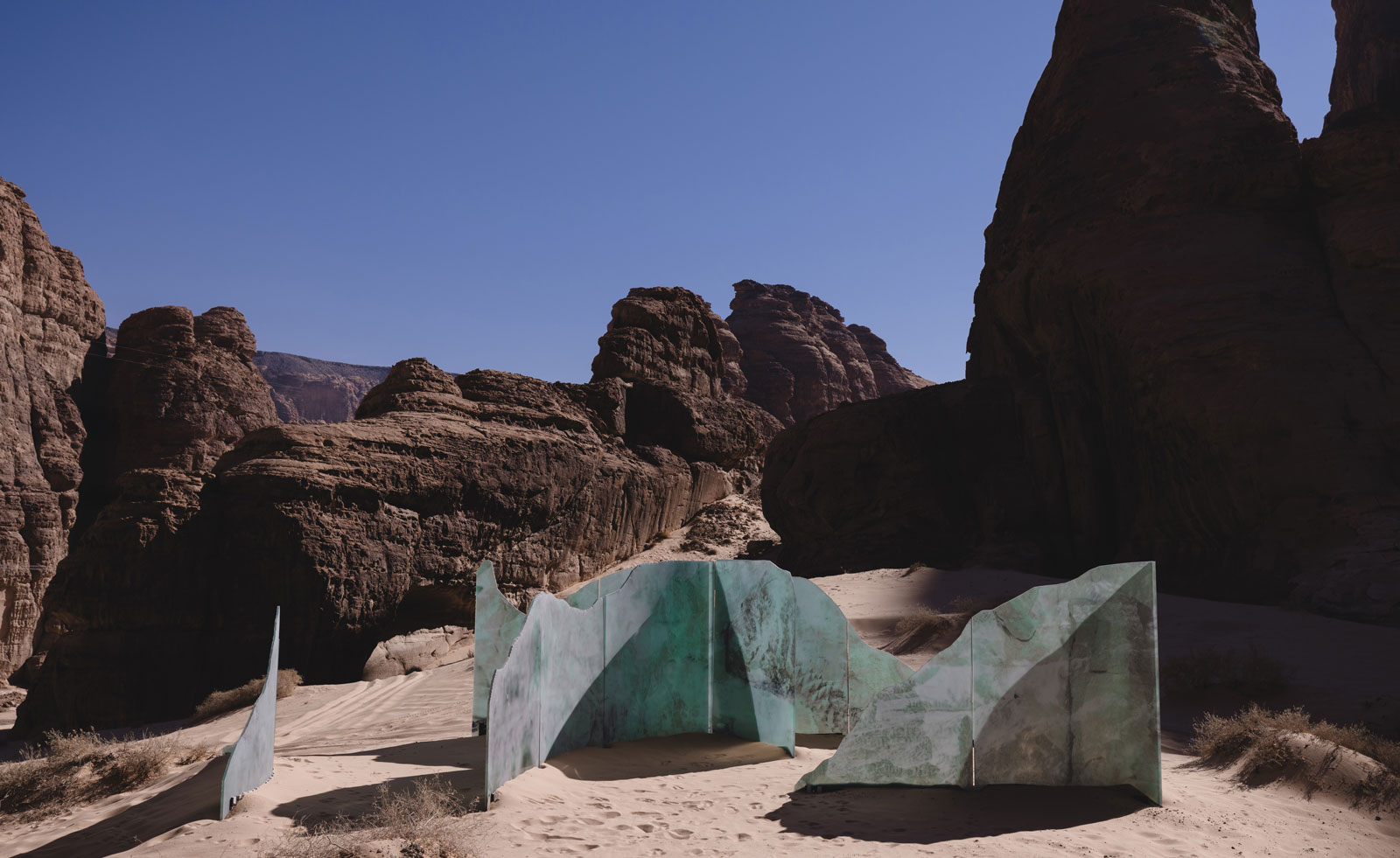 AlUla Arts Festival is putting Saudi Arabia’s flourishing art scene on the international stage
AlUla Arts Festival is putting Saudi Arabia’s flourishing art scene on the international stageReturning for its fourth edition, the AlUla Arts Festival celebrates art in a natural landscape; Lauren Ho went to discover more
By Lauren Ho
-
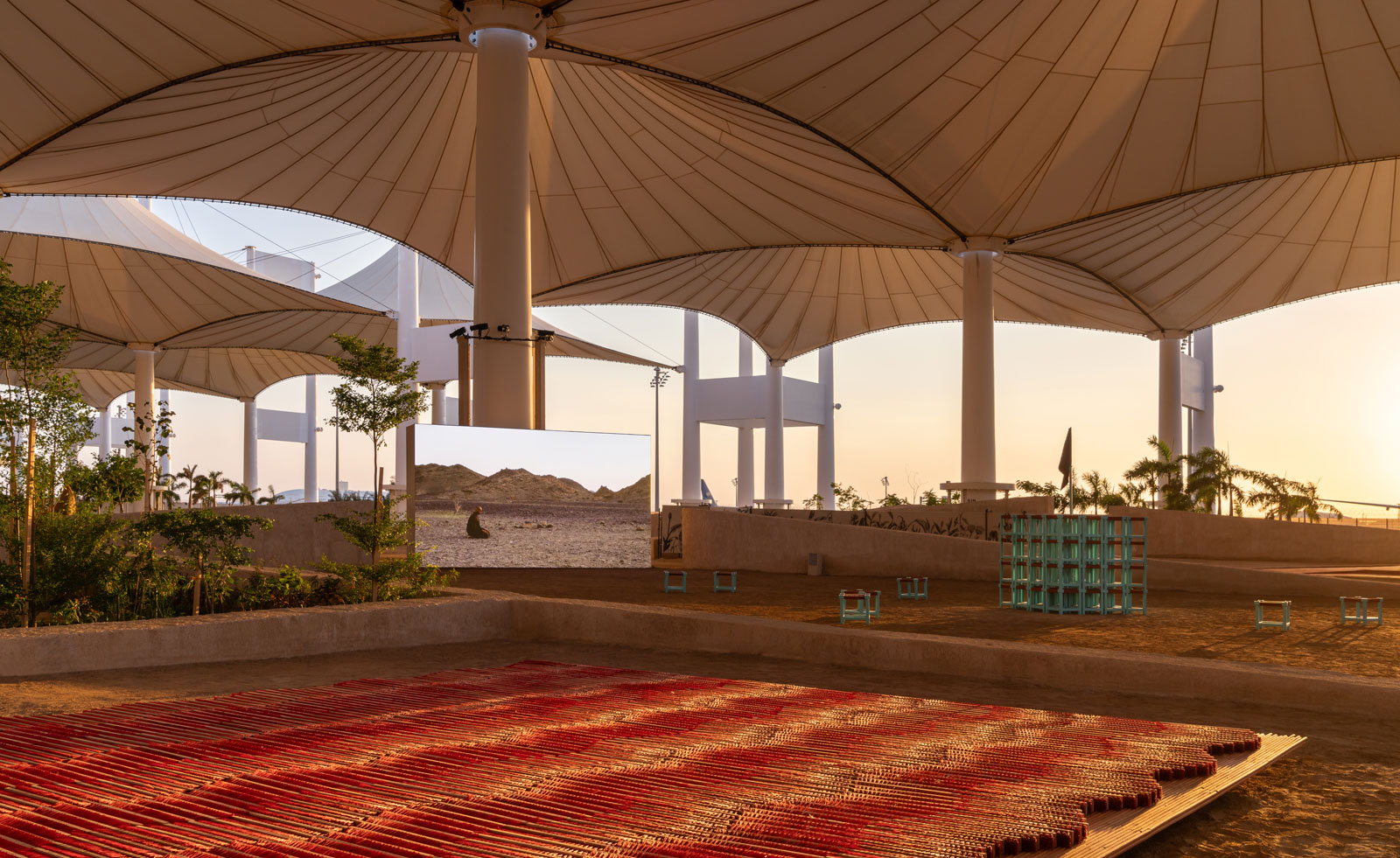 'Refined, serene, provocative': inside the Islamic Arts Biennale 2025
'Refined, serene, provocative': inside the Islamic Arts Biennale 2025We visit the Islamic Arts Biennale in Jeddah, open from now until the end of May, and explore a nimble curation that juxtaposes the ancient and the contemporary
By Harriet Quick
-
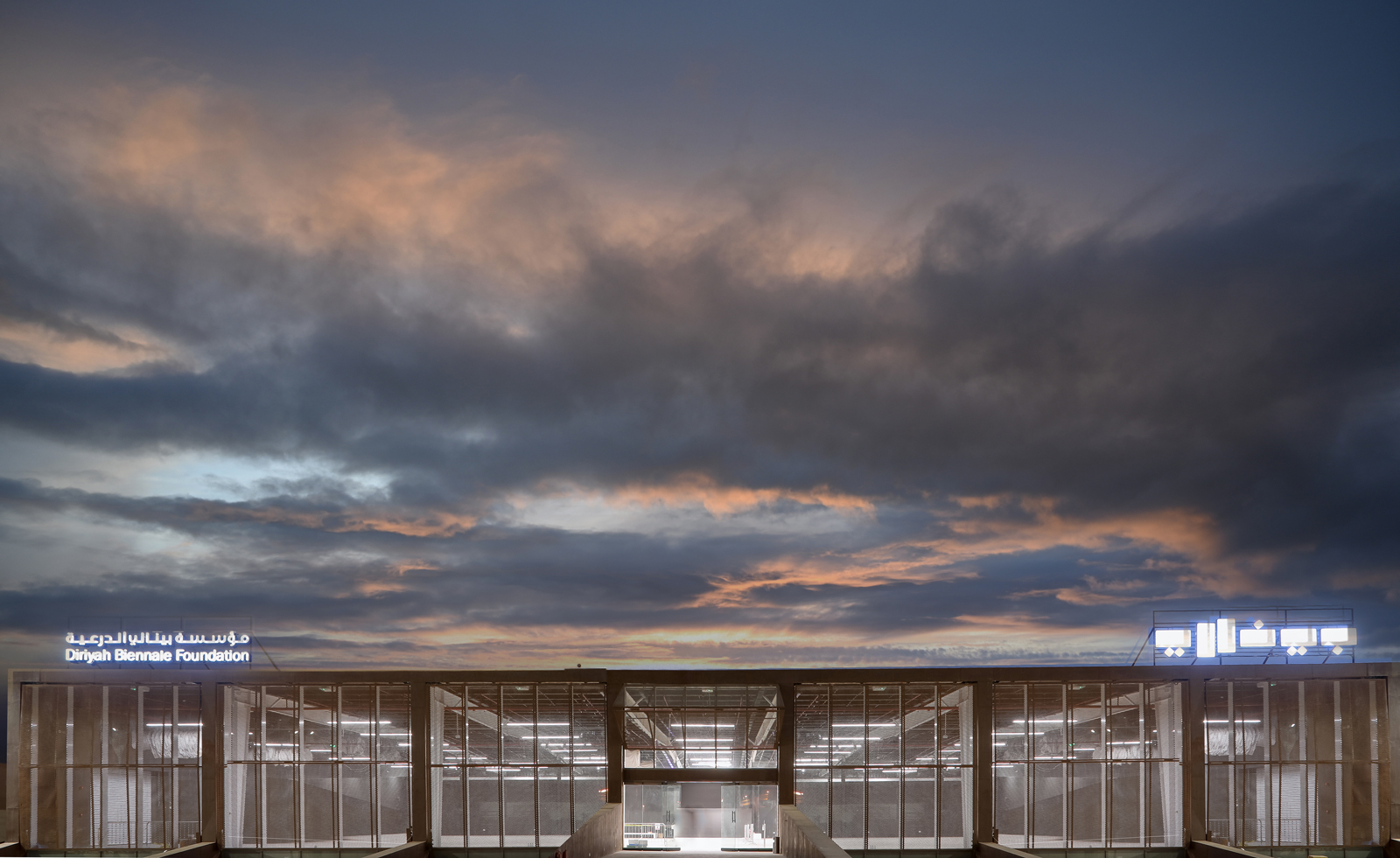 Diriyah Contemporary Art Biennale 2024 considers the future of Saudi Arabia
Diriyah Contemporary Art Biennale 2024 considers the future of Saudi ArabiaArtistic director Ute Meta Bauer oversees Diriyah Contemporary Art Biennale 2024, exploring themes of transition and reflection in Saudi Arabia
By Harriet Quick